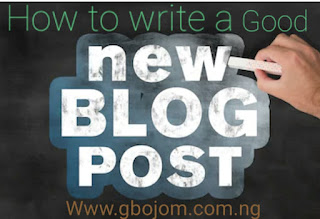By:CALLISTUS CAJETAN
Whether you want to start a blog as a hobby, as a step off or as a tool to promote your book ... your blog must be structured and well written.
Of course blogs offer a lot of freedom. You do not have to write in a certain length as you will write if you write a newspaper or article in a journal. You can write short, long, deep, or something in the middle.
You also have the freedom to choose your own topic - and to develop your own writing style. You might want to write nostalgic, soft, and funny blog entries that come from your own life ... or you'd rather make detailed and convincing lessons for new WordPress users.
Whatever you write and whatever the reasons for blogging, your blog posts will work. They must have a recognizable structure ... and must remain more or less in essence.
To write a good blog:
Step 1: Plan your contribution before you write
Your blog must have an introduction, a basic body, and conclusions (or, if you like, beginning, middle and end). How it works:
The introduction must set the scene for your posts and add readers. You can do this by asking questions, making bold statements, or making brief anecdotes about your own life.
The main part is the actual content of your posts. you can develop a specific discussion flow, share stories or give advice or tips about a particular topic.
The conclusion ends your contribution. It's easy to miss - but it's very important. It must be briefly summarized and ideally suggest to the reader to do something further.
Step 2: Create a complete post
While different bloggers work differently, I find that it is usually best to make a whole blog post from start to finish (rather than writing a few paragraphs here and there to gather). You can:
Imagine sending a friend while writing. Thinking about readers helps me make the project as smooth as possible.
Write a few short notes on your introduction and start with the first key points you want to make. It's often easier to enter an entry after you write the actual order.
Avoid editing when typing. If you need to fix fast text or restart random sentences, it's okay - but don't delete the entire paragraph at this time. When you are in the middle of the design, it is difficult to see what will happen and what remains.
Step # 3: Improve your post
After you get the rough concept of your post, it's time to design it for your blog. Since writing for an online audience, the following are important:
Keep your heels short. It's harder to read on screen than in print. If you are used to writing books or magazines, you might need to divide the paragraph in half.
Keep your sentences short and clear. Sometimes more complicated sentences are good - especially if you write for an educated or well-educated audience - but mix a few short and simple sentences.
Use conversation style. This means "me" and "you". They are not suitable for academic writing, so you might be taught not to use them in school ... but when you write on a blog, it's good to write as if you were speaking directly to the reader. (As I do now!)
Step 4: Format your contribution
If you are satisfied with the post, you must switch to formatting - what your e-mail looks like. Maybe you want:
Enter subtitles and / or bold text. They help "guide" the important parts of your contribution to the reader - for example, the different steps in this post have their own subtitles so you can easily find out where you are in the post.
If necessary, add images. Many bloggers start their posts with striking images to attract readers. Images also help make "empty" (empty bits on the page around words and images), which makes your email more interesting. and invite.
Add a link to another post (on your blog or elsewhere). The big advantage of writing online compared to writing is that you can connect to other sources. This might mean that you contact an explanation for something you mentioned in an instant, for example, to help your new readers in your area.
Step 5: Edit your post
Although you can make edits before formatting, I think it's very useful to make edits quickly, at least after placing subtitles, images, and links on the site.
When editing:
Beware of typos and mistakes. Not all spellcheckers are detected by default. Some bloggers find it useful to preview their email or preview them on their blog so that errors can be highlighted.
Make sure your link works. This is disappointing for the reader (and for you awkward) if a post with a broken link appears.
Look for areas where your post can be polished. For example, in this post, I re-edited to make sure each "level" had three bullets so that they all matched.
Of course, writing blog posts is more an art than a science - and I certainly don't want you to think that there is only one "right" way. However, these tips will help you to create sophisticated blog posts that are good to write and easy for your readers to connect.















0 Comments
be free to comment
here